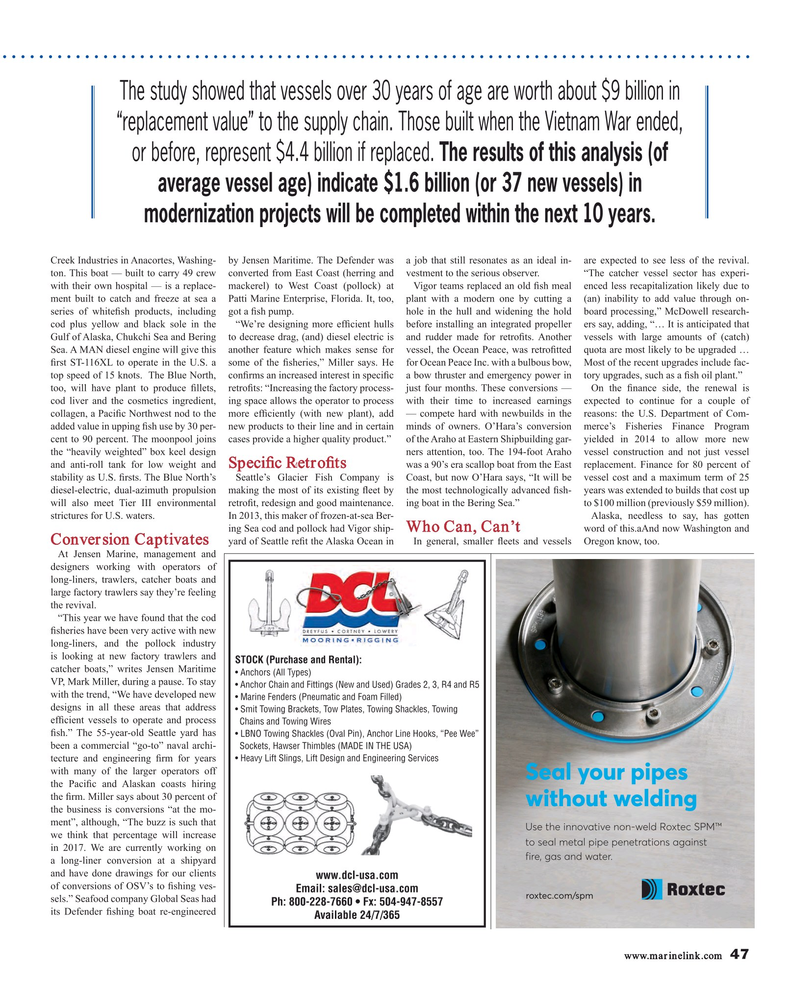
Page 47: of Maritime Reporter Magazine (January 2017)
The Ship Repair & Conversion Edition
Read this page in Pdf, Flash or Html5 edition of January 2017 Maritime Reporter Magazine
The study showed that vessels over 30 years of age are worth about $9 billion in “replacement value” to the supply chain. Those built when the Vietnam War ended, or before, represent $4.4 billion if replaced. The results of this analysis (of average vessel age) indicate $1.6 billion (or 37 new vessels) in modernization projects will be completed within the next 10 years.
Creek Industries in Anacortes, Washing- by Jensen Maritime. The Defender was a job that still resonates as an ideal in- are expected to see less of the revival. ton. This boat — built to carry 49 crew converted from East Coast (herring and vestment to the serious observer. “The catcher vessel sector has experi- with their own hospital — is a replace- mackerel) to West Coast (pollock) at Vigor teams replaced an old ? sh meal enced less recapitalization likely due to ment built to catch and freeze at sea a Patti Marine Enterprise, Florida. It, too, plant with a modern one by cutting a (an) inability to add value through on- series of white? sh products, including got a ? sh pump. hole in the hull and widening the hold board processing,” McDowell research- cod plus yellow and black sole in the “We’re designing more ef? cient hulls before installing an integrated propeller ers say, adding, “… It is anticipated that
Gulf of Alaska, Chukchi Sea and Bering to decrease drag, (and) diesel electric is and rudder made for retro? ts. Another vessels with large amounts of (catch)
Sea. A MAN diesel engine will give this another feature which makes sense for vessel, the Ocean Peace, was retro? tted quota are most likely to be upgraded … ? rst ST-116XL to operate in the U.S. a some of the ? sheries,” Miller says. He for Ocean Peace Inc. with a bulbous bow, Most of the recent upgrades include fac- top speed of 15 knots. The Blue North, con? rms an increased interest in speci? c a bow thruster and emergency power in tory upgrades, such as a ? sh oil plant.” too, will have plant to produce ? llets, retro? ts: “Increasing the factory process- just four months. These conversions — On the ? nance side, the renewal is cod liver and the cosmetics ingredient, ing space allows the operator to process with their time to increased earnings expected to continue for a couple of collagen, a Paci? c Northwest nod to the more ef? ciently (with new plant), add — compete hard with newbuilds in the reasons: the U.S. Department of Com- added value in upping ? sh use by 30 per- new products to their line and in certain minds of owners. O’Hara’s conversion merce’s Fisheries Finance Program cent to 90 percent. The moonpool joins cases provide a higher quality product.” of the Araho at Eastern Shipbuilding gar- yielded in 2014 to allow more new the “heavily weighted” box keel design ners attention, too. The 194-foot Araho vessel construction and not just vessel
Speci? c Retro? tsand anti-roll tank for low weight and was a 90’s era scallop boat from the East replacement. Finance for 80 percent of stability as U.S. ? rsts. The Blue North’s Seattle’s Glacier Fish Company is Coast, but now O’Hara says, “It will be vessel cost and a maximum term of 25 diesel-electric, dual-azimuth propulsion making the most of its existing ? eet by the most technologically advanced ? sh- years was extended to builds that cost up will also meet Tier III environmental retro? t, redesign and good maintenance. ing boat in the Bering Sea.” to $100 million (previously $59 million). strictures for U.S. waters. In 2013, this maker of frozen-at-sea Ber- Alaska, needless to say, has gotten ing Sea cod and pollock had Vigor ship- word of this.aAnd now Washington and
Who Can, Can’t
Conversion Captivates yard of Seattle re? t the Alaska Ocean in In general, smaller ? eets and vessels Oregon know, too.
At Jensen Marine, management and designers working with operators of long-liners, trawlers, catcher boats and large factory trawlers say they’re feeling the revival.
“This year we have found that the cod ? sheries have been very active with new long-liners, and the pollock industry is looking at new factory trawlers and
STOCK (Purchase and Rental): catcher boats,” writes Jensen Maritime s

 46
46

 48
48
